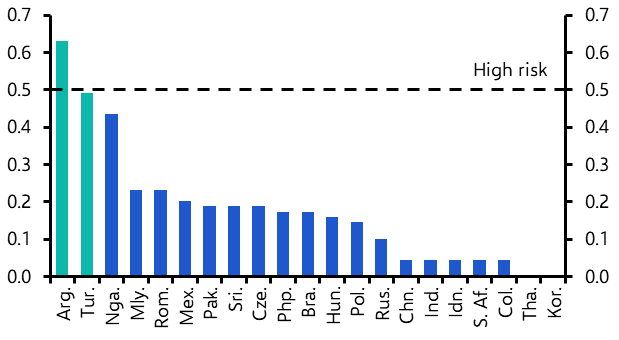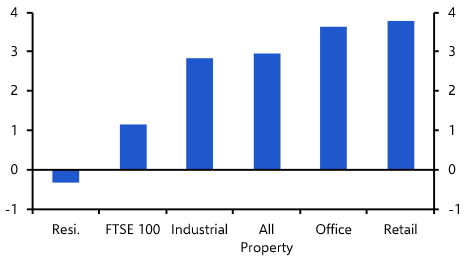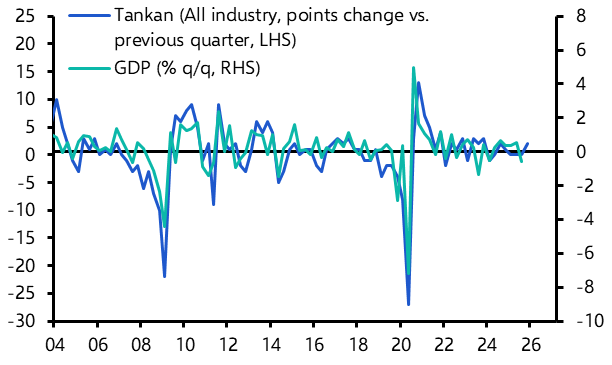Developments over the past week or so have emboldened both the optimists and the pessimists.
The good news is that the incoming data continue to suggest a recovery that is about as v-shaped as we could reasonably have hoped for. Our Recovery Trackers, which provide a real-time snapshot of conditions and are discussed in more detail here, illustrate the extent to which activity has rebounded over the past month or so. (See Chart 1.) This is now starting to show up in the official activity data. Retail sales in the US have now recouped two-thirds of their fall. In Germany, sales are already back to their pre-virus level.
Chart 1: Capital Economics Covid Recovery Trackers
 Sources: Google, Apple, Moovit, Oxford University, Capital Economics
Sources: Google, Apple, Moovit, Oxford University, Capital EconomicsThe bad news is that sustaining the pace of recovery will get increasingly difficult from here.
For a start, the alarming rise in new infections in several “Sun Belt” states in the south of the US is a reminder that the path out of lockdowns will not be smooth.
One lesson from the initial outbreaks of infections both in the north east of the US but also in Europe and Asia is that economic damage is caused by the response to the virus – in particular efforts to contain it by shuttering parts of the economy – rather than the virus itself. To this end, the re-imposition of some restrictions in states that have seen a spike in infections is likely to depress local activity. At an aggregate level, economic weakness in the Sun Belt will be offset in part by a rebound in activity in states in the north east that are continuing to open up. Even so, as Chart 2 shows, there are early signs that the US recovery is starting to level out.
Chart 2: US Google Mobility* (% from pre-virus level)
 Sources: Google, Capital Economics
Sources: Google, Capital EconomicsMoreover, the Sun Belt states are unlikely to be an outlier. As restrictions on mobility are lifted, new “hotspots” are likely to emerge elsewhere too. The process of reopening economies is likely to be a stop-start one.
Our assumption is that governments will be able to contain new outbreaks of the virus without resorting to nationwide lockdowns. This has been borne out by the fact that flare-ups in Beijing and in North Rhine-Westphalia in Germany have been suppressed without the widespread imposition of new restrictions.
However, in practice the ability of governments to stamp out new outbreaks will vary from country to country, depending on factors like popular compliance with distancing rules when asked and the effectiveness of the public health response, including the tracking, tracing and isolation of infected people. It follows that governments that fall short in these areas are more susceptible to economic recoveries stalling or even reversing.
Meanwhile, even in those countries that manage to avoid new outbreaks, it is likely that the easy economic wins from lifting lockdowns have already happened. On the supply-side, a full re-opening of workplaces and businesses beyond what’s now happened in most countries will require either a vaccine or widespread herd immunity. On the demand side, a lot now depends on the extent to which the savings that were accumulated by some households during lockdowns are now run down and demand reflates. This will be determined to a large extent by factors outside of the control of economic policymakers – in particular, the extent to which governments are able to reassure citizens that economies can reopen safely and that new outbreaks can be contained without the resort to new national lockdowns. Where fear and caution prevail, the capacity to provide additional fiscal support will be key. Some emerging economies look particularly exposed on this front.
Put all of this together and, while much remains uncertain, the one thing we can be reasonably sure about is that the easy part of the recovery may already be behind us.
In case you missed it:
- Our Senior Economic Advisor, Vicky Redwood, argues that, while a full economic recovery will take time, the pandemic may not deal a lasting blow to supply potential.
- Our markets team assess asset allocation in the next stage of the pandemic and conclude risky assets should continue to outperform.
- Our Senior China Economist, Julian Evans Pritchard, Europe Economist, argues that growing strains with the rest of the world will encourage China’s leaders to double-down on a state-led model of development that will ultimately weigh on growth.




